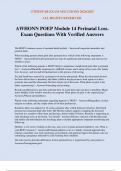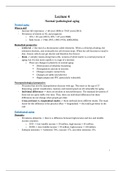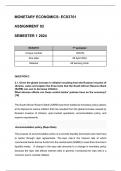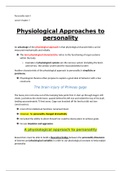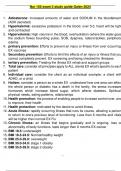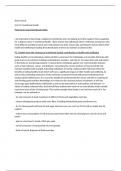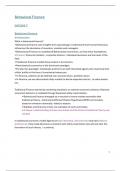.
Unit 4: Laboratory techniques and their applications.
Learning Aim C: To explore manufacturing techniques and testing methods
from an organic solid.
Introduction
I am working as a lab technician to explore and research the development department of a
pharmaceutical company. Aspirin is a product made in the pharmaceutical companies across
the world. I am investigating how to make and examine the purity aspirin to aid my
company in producing it efficiently. I will also be producing my own sample of aspirin and
use my selected method to test its purity, comparing my chosen technique to methods used
in the industry to produce aspirin on a larger scale.
What is aspirin?
Aspirin is a common medicine used to treat pain. As well pain, it can also be used for
reducing symptoms of the flu and reducing inflammation. Certain illnesses such as Kawasaki
disease and rheumatoid fever can use aspirin as a drug for treatment.
Risk Assessment for practical
Hazard Risk How it can be prevented
Exposure to fumes from the Can damage the respiratory Wearing PPE such as a
substance being produced tract and burn the eyes mask, goggles, and gloves
Bags and objects not Can lead to falls and trips Ensure that all bags, coats
properly placed away which can occur in serious and things that aren’t being
injury used are packed away
Hydroxybenzoic acid is an Can cause damage to the Ensure not to swallow and
irritant and corrosive eyes and is lethal if it is wear gloves
swallowed
Hydroxybenzoate is an Can cause irritation to the Once finished, through this
irritant and harmful to the skin and if spilt down the product in the bin and
environment drain it is harmful to aquatic ensure that you are wearing
life correct PPE such as gloves,
goggles, and a mask
Aspirin is an irritant Can cause irritation and Create a barrier with your
pain to the respiratory tract skin and aspirin. You can do
and inflammation/ irritation this by wearing PPE. Also,
to the eyes. ensure not to swallow it.
,Method for making Aspirin in the lab
Part A- preparation of aspirin
Equipment
1. Salicylic acid
2. 100cm3 conical flask
3. 100cm3 beaker
4. Ethanoic anhydride
5. Beaker 400cm3
6. Sulfuric acid that is concentrated in dropping bottle
7. Gauze
8. Buchner funnel
9. Filter paper
10. Vacuum flask
11. Rubber tubbing
12. Stirring rod
13. Spatula
14. Tripod and Bunsen burner
15. Thermometer
16. Weighing boat and scales
17. Distilled water in wash bottle
18. 250cm3 beaker
19. 10cm3 measuring cylinder
Method P5, M4
M4M4
1. First, I placed the weighing boat on the centre of the weighing scales. Then I zeroed
the balance and using a spatula, I transferred 6g of salicylic acid to the weighing
boat.
2. I then transferred the 6g of salicylic acid to an 100cm3 conical flask.
3. Using a 10cm3 measuring cylinder I measured 10cm3 of ethanoic anhydride to and
transferred it to the conical flask with the salicylic acid. I then swirled the contents
for 3 minutes.
4. After I transferred 5 drops of concentrated sulfuric acid to the conical flask. I the
swirled the contents for another 3 minutes which allowed the solution to mix fully.
5. Following that, I transferred 250cm3 of water to the 400cm3 measuring cylinder.
, 6. I then placed the conical flask inside the beaker. After I transferred the beaker with
the conical flask inside on top of the Bunsen burner.
7. Once the water reached 60oc and the content inside the conical flask reached 65oc I
removed the flask from the measuring cylinder. I then placed the flask on a cool
surface allowing I to cool down. This is the process of recrystallisation.
8. After I measured 75 cm3 of distilled water to a 100cm3 beaker. Following that I used
a stirring rod to scrape out the contents of the conical flask and transferred it to the
water.
9. Using the process of vacuum filtration, I used the Buchner funnel under reduced
pressure (using a rubber tubbing connected to a water pressure) to filter off the
aspirin.
This is the set up:
10. I then collected the crude aspirin on a double lined filter paper and allowed it to dry.
Steps in my method that were skilful
One step in my method that required skill was knowing how to safely and properly use the
Buchner funnel and flask set up. This is because there were some risks that could have
occurred such as the Buchner funnel breaking. As the material it is made from- glass, is quite
delicate it could have easily broken. However, I meticulously handled it which allowed me to
not have any dangers or problems whilst using it.
Unit 4: Laboratory techniques and their applications.
Learning Aim C: To explore manufacturing techniques and testing methods
from an organic solid.
Introduction
I am working as a lab technician to explore and research the development department of a
pharmaceutical company. Aspirin is a product made in the pharmaceutical companies across
the world. I am investigating how to make and examine the purity aspirin to aid my
company in producing it efficiently. I will also be producing my own sample of aspirin and
use my selected method to test its purity, comparing my chosen technique to methods used
in the industry to produce aspirin on a larger scale.
What is aspirin?
Aspirin is a common medicine used to treat pain. As well pain, it can also be used for
reducing symptoms of the flu and reducing inflammation. Certain illnesses such as Kawasaki
disease and rheumatoid fever can use aspirin as a drug for treatment.
Risk Assessment for practical
Hazard Risk How it can be prevented
Exposure to fumes from the Can damage the respiratory Wearing PPE such as a
substance being produced tract and burn the eyes mask, goggles, and gloves
Bags and objects not Can lead to falls and trips Ensure that all bags, coats
properly placed away which can occur in serious and things that aren’t being
injury used are packed away
Hydroxybenzoic acid is an Can cause damage to the Ensure not to swallow and
irritant and corrosive eyes and is lethal if it is wear gloves
swallowed
Hydroxybenzoate is an Can cause irritation to the Once finished, through this
irritant and harmful to the skin and if spilt down the product in the bin and
environment drain it is harmful to aquatic ensure that you are wearing
life correct PPE such as gloves,
goggles, and a mask
Aspirin is an irritant Can cause irritation and Create a barrier with your
pain to the respiratory tract skin and aspirin. You can do
and inflammation/ irritation this by wearing PPE. Also,
to the eyes. ensure not to swallow it.
,Method for making Aspirin in the lab
Part A- preparation of aspirin
Equipment
1. Salicylic acid
2. 100cm3 conical flask
3. 100cm3 beaker
4. Ethanoic anhydride
5. Beaker 400cm3
6. Sulfuric acid that is concentrated in dropping bottle
7. Gauze
8. Buchner funnel
9. Filter paper
10. Vacuum flask
11. Rubber tubbing
12. Stirring rod
13. Spatula
14. Tripod and Bunsen burner
15. Thermometer
16. Weighing boat and scales
17. Distilled water in wash bottle
18. 250cm3 beaker
19. 10cm3 measuring cylinder
Method P5, M4
M4M4
1. First, I placed the weighing boat on the centre of the weighing scales. Then I zeroed
the balance and using a spatula, I transferred 6g of salicylic acid to the weighing
boat.
2. I then transferred the 6g of salicylic acid to an 100cm3 conical flask.
3. Using a 10cm3 measuring cylinder I measured 10cm3 of ethanoic anhydride to and
transferred it to the conical flask with the salicylic acid. I then swirled the contents
for 3 minutes.
4. After I transferred 5 drops of concentrated sulfuric acid to the conical flask. I the
swirled the contents for another 3 minutes which allowed the solution to mix fully.
5. Following that, I transferred 250cm3 of water to the 400cm3 measuring cylinder.
, 6. I then placed the conical flask inside the beaker. After I transferred the beaker with
the conical flask inside on top of the Bunsen burner.
7. Once the water reached 60oc and the content inside the conical flask reached 65oc I
removed the flask from the measuring cylinder. I then placed the flask on a cool
surface allowing I to cool down. This is the process of recrystallisation.
8. After I measured 75 cm3 of distilled water to a 100cm3 beaker. Following that I used
a stirring rod to scrape out the contents of the conical flask and transferred it to the
water.
9. Using the process of vacuum filtration, I used the Buchner funnel under reduced
pressure (using a rubber tubbing connected to a water pressure) to filter off the
aspirin.
This is the set up:
10. I then collected the crude aspirin on a double lined filter paper and allowed it to dry.
Steps in my method that were skilful
One step in my method that required skill was knowing how to safely and properly use the
Buchner funnel and flask set up. This is because there were some risks that could have
occurred such as the Buchner funnel breaking. As the material it is made from- glass, is quite
delicate it could have easily broken. However, I meticulously handled it which allowed me to
not have any dangers or problems whilst using it.

